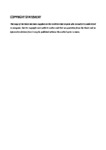Disentangling the roles of social and physical environment in driving reproductive plasticity
| dc.contributor.supervisor | Thom, Michael | |
| dc.contributor.author | Churchill, Emily Rose | |
| dc.contributor.other | School of Biological and Marine Sciences | en_US |
| dc.date.accessioned | 2021-08-13T06:08:17Z | |
| dc.date.issued | 2021 | |
| dc.identifier | 10538612 | en_US |
| dc.identifier.uri | http://hdl.handle.net/10026.1/17574 | |
| dc.description | A version of chapter 3 has been published, and is available online as: Churchill, E. R., Bridle, J. R. & Thom, M. D. F. (2020) ‘Spatially clustered resources increase male aggregation and mating duration in Drosophila melanogaster’. Animal Behaviour, 169, pp. 45-50. A version of chapter 5 has been accepted for publication in Behavioral Ecology. A pre published version is available online as: Churchill, E. R., Dytham, C., Bridle, J. R. & Thom, M. D. F. (2021) ‘Social and physical environment independently affect oviposition decisions in Drosophila melanogaster’. bioRxiv. 2021.01.27.428229. | en_US |
| dc.description.abstract |
Resource patchiness results in spatially fluctuating population densities and thus variable levels of competition. If different traits are favoured in different population densities, individuals should adjust their physiology and behaviour in response, to maximise their fitness. In this thesis I manipulate resource distributions to investigate the implications this has on the social environment, and the sex differences in subsequent reproductive responses. Under high levels of perceived sperm competition, male Drosophila melanogaster will lengthen copulation durations. Despite this being a well established responses, little is known about the biological mechanism that facilitates this behaviour, as most of the studies that have demonstrated it have done so by comparing solitary males to paired (or grouped) males – social environments unlikely to be experienced by wild living males. Given that resource patchiness affects encounter rates, I predicted that this ecological variability might be one of the natural stimuli affecting plasticity in mating-related traits in the wild. Here I demonstrate that these sperm competition linked responses respond to spatial heterogeneity: males on clustered food resources were found in closer proximity to rivals, and consequently had longer copulation durations (Chapter 3). I then expand on this work by matching individual movement patterns in a variably patchy environment with individual-level mating behaviour and fitness (Chapter 4). I show that clustered food resources not only result in increased encounter rates, but also reduced home range size. Surprisingly, however, I find no evidence of fitness impacts associated with these responses. Alongside increased copulation duration, males also increase sperm transfer, improve sperm quality and alter seminal fluid composition after exposure to rivals – and intriguingly have longer lifespans, although it is not understood how or why. To attempt to better understand this unexpected result, I compare survival impacts in males exposed to direct rival interactions (exposed to likely injurious aggression) and males only exposed to rivals via a barrier (Chapter 2). It appears that indirect exposure is beneficial for starvation resistance, but direct interactions result in longer lifespans. In addition, I discover that these survival benefits are only activated by male and not female presence. Comparatively little is known about female responses to environmental variability and conspecific presence. This is surprising given that females have greater control over progeny investment due to their role in oviposition. I address this knowledge gap by exploring the impact of resource patchiness and competition on oviposition decisions. I demonstrate that females show a preference for clustered resources (with a higher number of females choosing to lay on clustered patches, and also then laying on a higher number of patches), likely due to the benefit of cooperative foraging in larvae. Interestingly, the impacts of competition differed when exposure to rivals was experienced prior to, rather than during, oviposition. After prior exposure to competition, females laid fewer eggs (Chapter 5) whereas this effect disappeared when females were laying in the presence of another female (Chapter 6). This suggests that those females were copying conspecific oviposition decisions, minimising exploration costs and enabling them to lay a higher number of eggs. | en_US |
| dc.language.iso | en | |
| dc.publisher | University of Plymouth | |
| dc.rights | Attribution-NonCommercial-NoDerivs 3.0 United States | * |
| dc.rights.uri | http://creativecommons.org/licenses/by-nc-nd/3.0/us/ | * |
| dc.subject | Reproduction | en_US |
| dc.subject | Spatial distribution | en_US |
| dc.subject | Sperm competition | en_US |
| dc.subject | Oviposition | en_US |
| dc.subject | Copulation duration | en_US |
| dc.subject | Sexual selection | en_US |
| dc.subject | Plasticity | en_US |
| dc.subject | Sexual conflict | en_US |
| dc.subject | Mating behaviour | en_US |
| dc.subject.classification | PhD | en_US |
| dc.title | Disentangling the roles of social and physical environment in driving reproductive plasticity | en_US |
| dc.type | Thesis | |
| plymouth.version | publishable | en_US |
| dc.identifier.doi | http://dx.doi.org/10.24382/1070 | |
| dc.rights.embargodate | 2022-08-13T06:08:17Z | |
| dc.rights.embargoperiod | 12 months | en_US |
| dc.type.qualification | Doctorate | en_US |
| rioxxterms.version | NA | |
| plymouth.orcid_id | 0000-0003-0910-8600 | en_US |
Files in this item
This item appears in the following Collection(s)
-
01 Research Theses Main Collection
Research Theses Main



